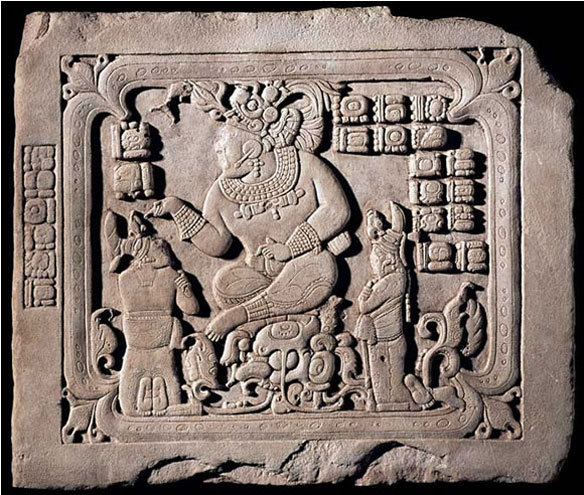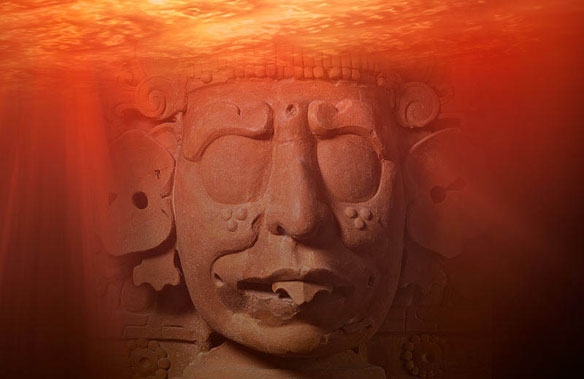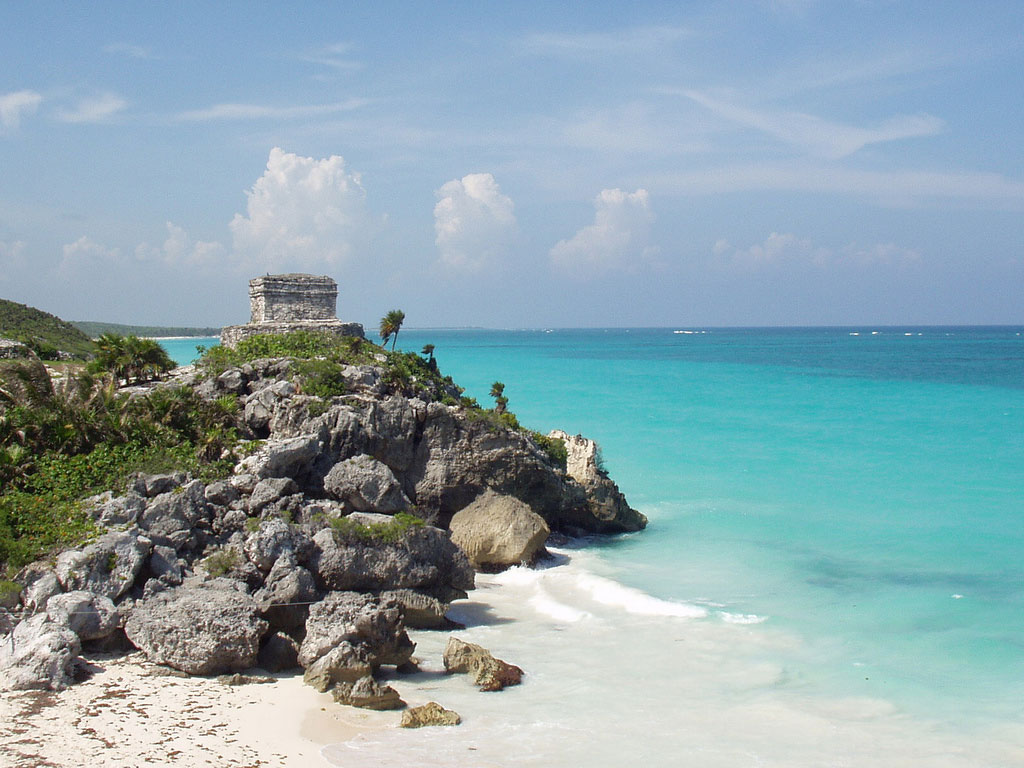
Mayan coast, Tulum, Mexico. Photo source: ©© Jeff Stvan
By NOAA
NOAA-sponsored explorers are searching a wild, largely unexplored and forgotten coastline for evidence and artifacts of one of the greatest seafaring traditions of the ancient New World, where Maya traders once paddled massive dugout canoes filled with trade goods from across Mexico and Central America.
One exploration goal is to discover the remains of a Maya trading canoe, described in A.D. 1502 by Christopher Columbus’ son Ferdinand, as holding 25 paddlers plus cargo and passengers.
Through the end of May, the team is exploring the remote jungle, mangrove forests and lagoons at the ancient port site of Vista Alegre (“happy view” in Spanish) where the Caribbean meets the Gulf of Mexico at the northeastern tip of the Yucatan Peninsula. Scientists believe the port was part of an important trading network and was used at various times between about 800 B.C. and A.D. 1521, the date scholars use to designate the start of Spanish rule.
“The maritime Maya have been described much like ancient seagoing Phoenicians. They traded extensively in a wide variety of goods, such as bulk cotton and salt, and likely incense from tree sap called copal, jade, obsidian, cacao, Quetzal and other tropical bird feathers, and even slaves,” said Dominique Rissolo, Ph.D., expedition co-chief scientist and director of the Waitt Institute in La Jolla, Calif. “Maya trade was far-ranging between the Veracruz coast of modern Mexico and the Gulf of Honduras, with each port a link in a chain connecting people and ideas. Yet there is still much to learn about the extensive history and importance of the maritime Maya and how they adapted to life by the sea.”
“Maritime economies were strengthened and far-ranging trade routes were established between A.D. 850 and 1100,” said Jeffrey Glover, Ph.D., expedition co-chief scientist with Georgia State University’s Department of Anthropology in Atlanta. “It was during this time when the Maya at Chichen Itza relied increasingly on maritime commerce to maintain and extend control over much of the Yucatan peninsula. The period most associated with Maya seafaring followed, between A.D. 1100 and 1521.”

Panel with a seated ruler in a watery cave, Ministerio de Cultura y Deportes. Surrounded by the sea in all directions, the ancient Maya viewed their world as inextricably tied to water.The Maya viewed water as animate and intelligent, a living and thinking force with the power to influence events. Water was central to the structure of the universe and present at the beginning of time—oceans, rivers, springs, and rain were united, both literally and spiritually. Caption Peabody Essex Museum, and photograph © 2009 Jorge Pérez de Lara.
Recent archaeological work at Vista Alegre included completion of an architectural map of the site, test excavations to obtain cultural materials, and a 13-mile reconnaissance of coastal environments that revealed a number of small ancient and historical sites and cultural features.
During expeditions at the port site in 2005 and 2008, explorers mapped 29 structures including platforms, mounds, raised causeways, and a concrete-filled 35-foot tall, steep-sided pyramid that dominates the central plaza and appears to have been heavily damaged by hurricanes. Explorers believe the summit of the pyramid was also used by lookouts to monitor approaching and departing canoes. In addition to the features on the island, a narrow walkway connects the port to a collapsed and looted temple 0.8 miles away on the mainland.
The expedition team also includes co-chief scientists Patricia Beddows, Ph.D., of Northwestern University’s Department of Earth and Planetary Sciences in Evanston, Illinois; Beverly Goodman, Ph.D., of the Leon Charnet School of Marines Sciences at the University of Haifa, Israel; and Derek Smith, of the University of Washington Department of Biology. Emily McDonald of NOAA’s Office of Ocean Exploration and Research is on the team to coordinate Web coverage.
Two scientists from Mexico and a small number of U.S. students will join parts of the expedition, which will also provide post-expedition technical reports to the Mexican National Institute of Anthropology and History. A goal of the exploration is to enable Mexico to better protect and preserve its coastal and submerged cultural resources.
The explorers are contending with many of the same challenges that faced ancient Maya seafarers, including shelter, as some team members will be in tents and slung hammocks, the remoteness of the area that is accessible only by boat, the scarcity of fresh water, the possibility of tropical storms, and the danger and nuisance of a variety of local inhabitants, including mosquitoes, snakes, spiders and crocodiles.
“The Maya largely had to live off the land in this remote area where they found and used resources to survive. Like them, we have to search for scarce fresh water, but our challenges are more about making the research work in less than optimal conditions. It will involve some good MacGyvering,” said Glover, referring to the television actor who used ingenuity and materials at hand to invent his way out of a fix.
The expedition is part of Proyecto Costa Escondida (Hidden Coast Project), a long-term interdisciplinary research effort co-directed by Glover and Rissolo and focused on the dynamic relationship between the Maya and their coastal landscape.

Fiery Pool: The Maya and the Mythic Sea, an exhibition that showcases more than 90 works of Maya art, many shown for the first time in the United States, offering exciting new insights into Maya culture that focus on the sea as a defining feature of the spiritual realm and the inspiration for the finest works of art. More than a necessity to sustain life, water was the vital medium from which the world emerged, gods arose and ancestors communicated.
Fiery Pool: The Maya And The Mythic Seas, Opening Exhibition, Pictures









